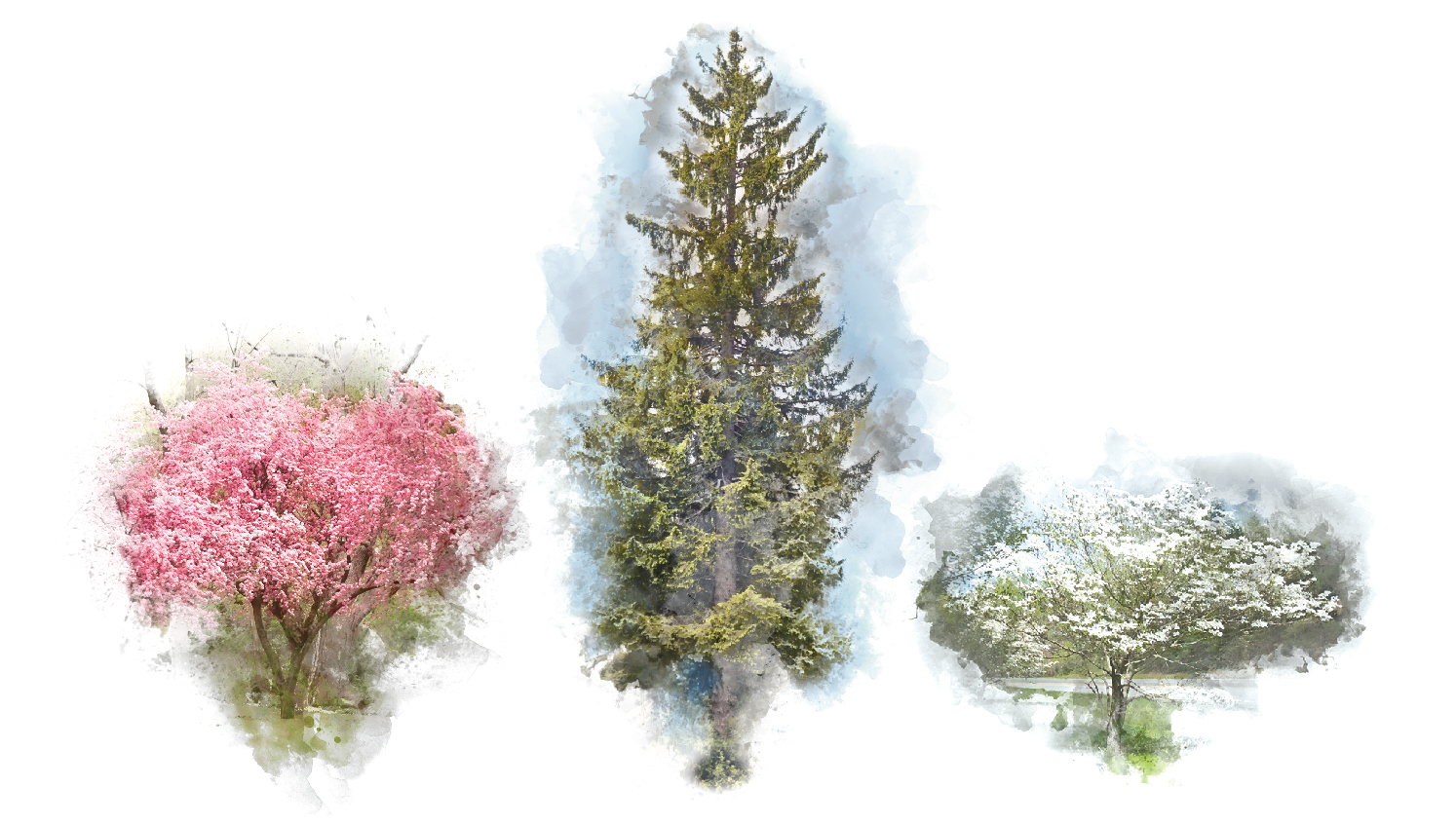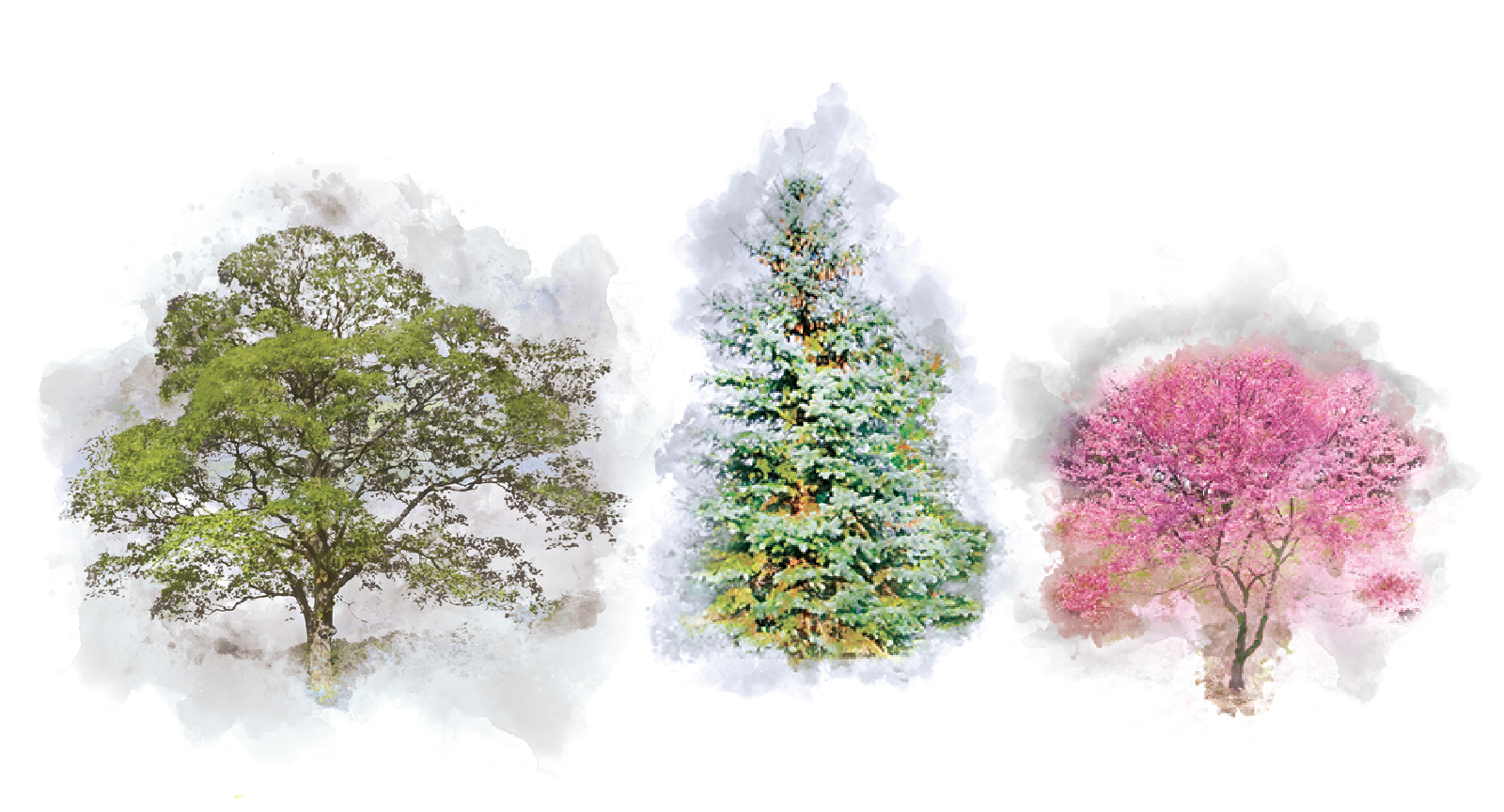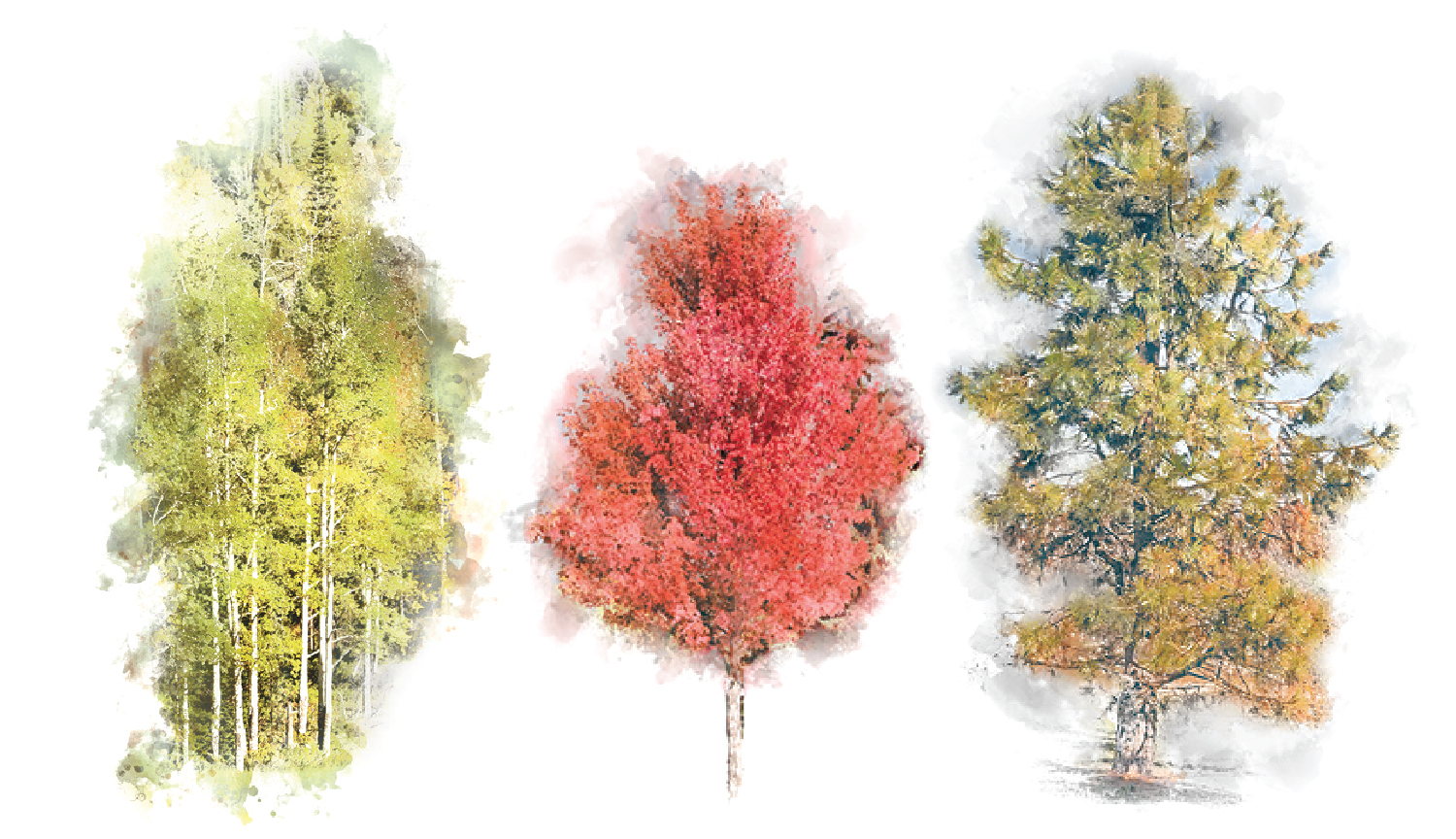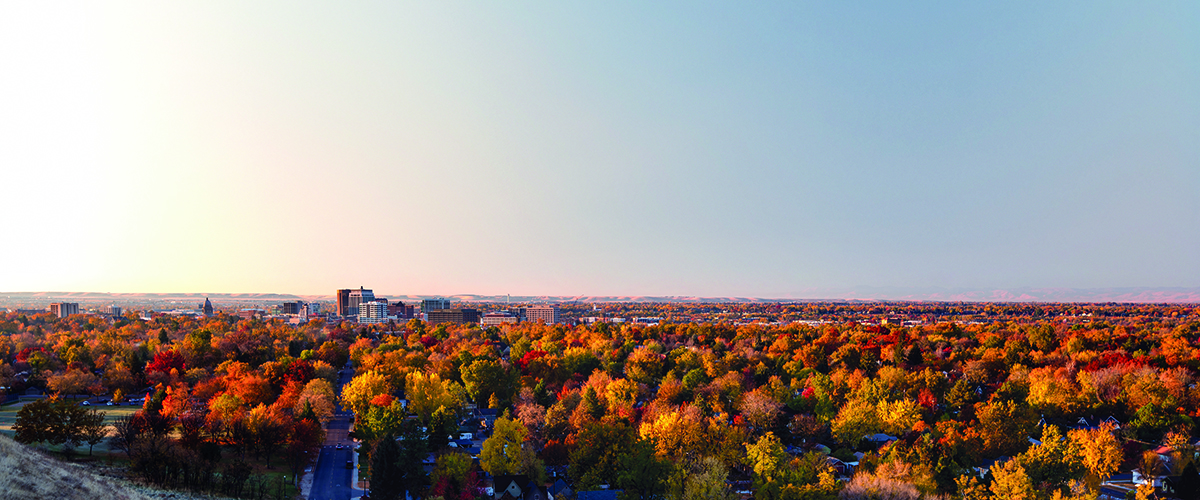Travel in from the vast Western desert by highway and wait for Boise, and soon there is an exit from the dreary brown into the green. A hawk flies and a red fox scratches its ear and the river calls, and all along its banks the trees begin to explain.
They whisper a legend that traveling French-Canadian fur trappers came upon a hill overlooking the tree-lined river and exclaimed, “Le Bois!” The trees! And you listen to the city and the seasons change and time begins to show how the fable has come true and how under the modern urban forest Boise’s history is rooted in its soil and the ever-spreading pattern of its connected canopy of trees.
Once home to native cottonwoods, aspen, willows, firs, pines and just a few other species, Boise now bursts with such a variety of trees that each season showcases its own thrillers, and everybody has a tree story: a huge sycamore they remember climbing; a blue spruce full of squirrels and birds; a landmark showy dogwood; a catalpa hit by lightening; a red maple they planted.
And when describing their view of the City of Trees—Boise’s official nickname—people speak in something like poetry: “When I think of Boise trees, I think of my perch anywhere along the bench or the foothills where you are just over the canopy and can see into the distance,” longtime Boise resident James Kent wrote online. “The trees that gave Boise its name are my favorite, the black cottonwood, and I have pictures of down valley winds carrying cottonseed so thick it looks like it’s snowing. The smell they give off in spring is defining.”
“I think of the view from Camel’s Back Park, which shows both the sea of trees in Boise and the lack thereof in the surrounding hills,” said Boise’s Rabbi, Dan Fink. “You stand atop this desert hill, covered with sage, and look down on all of the trees that fill the city. The contrast is marvelous and makes me so thankful for the trees that people have planted.”
The roots of Boise’s urban forest took hold not long after the city was platted in 1864. With editorial support from the Idaho Tri-Weekly Statesman, the city founders’ vision started what the newspaper called “Tree-Mania.” The intense heat of Boise summers was another motivation, and people began to plant with the idea of a shady town to call home. Some found familiarity in trees common to their old and new locations, and, responding to requests, Boise’s first tree nurseryman, Tom Davis, had trees brought from Illinois.
They came by rail and then stagecoach. He started with plum, cherry, crab apple, quince, mulberry, black walnut, balsam, fir, Norway spruce, box elder, sugar maple, and a few others. More than 150 years later, Boise’s urban forest rivals many larger cities in its beauty and the size of its canopy, which now covers about 30 percent of the town.
 Boise City Forester Brian Jorgenson’s connection to Boise’s trees is more than a favorite stand of birches or a glowing yellow honey locust. His job is managing Boise’s 50,000 public trees and the resources they need to stay healthy, as well as to continually expand the reach and improve the quality of the tree canopy. Jorgenson’s desire to help people find happiness through a tree-rich, healthy, outdoorsy community is written all over his own sunny face, and it’s inspirational. He educates people about trees’ positive influence on the local climate: reduced energy use, improved soil, air, and water quality, quieter environments, healthier urban wildlife, and expansion of biodiversity.
Boise City Forester Brian Jorgenson’s connection to Boise’s trees is more than a favorite stand of birches or a glowing yellow honey locust. His job is managing Boise’s 50,000 public trees and the resources they need to stay healthy, as well as to continually expand the reach and improve the quality of the tree canopy. Jorgenson’s desire to help people find happiness through a tree-rich, healthy, outdoorsy community is written all over his own sunny face, and it’s inspirational. He educates people about trees’ positive influence on the local climate: reduced energy use, improved soil, air, and water quality, quieter environments, healthier urban wildlife, and expansion of biodiversity.
Jorgenson manages more than a dozen staff who follow a strategic management plan that was a collaborative effort of Boise Community Forestry, the city’s Planning and Development Services department, and other groups that are a part of a public-private partnership called the Treasure Valley Canopy Network. It has 24 member groups, including city, county, and state agencies; conservation and sustainability nonprofits; professional associations; and Boise’s two main hospitals. Health is the key concept among all these stewards of the trees: air, water, soil, the community, and people.
The Canopy Network is a new project for Boise. Its coordinator, Lance Davisson, describes it as “a group of stakeholders who develop programs to help support the urban forest.” One of its subgroups, which includes Idaho Power Company, the Idaho Department of Lands, and the Arbor Day Foundation’s Energy Saving Trees Program, has teamed up for the Treasure Valley Shade Tree Project, which aims to provide shade trees to homeowners for planting on the west side of their homes. This project, funded by the U.S. Forest Service, focuses on energy conservation. Its interesting website (tvcanopy.net) has an animated graphic showing the dramatic difference in temperature on each of the four sides of a house. According to Idaho Power, planting a shade tree to the West of a Treasure Valley home can result in up to 15 percent reduction in summer cooling costs, and, as a result, helps reduce air pollution.
Clean air is foremost in the minds of city foresters everywhere. “It’s never been an expectation that trees alone will save the planet, but I like to think of urban trees as the front line in fighting air pollution at the source,” said Jorgenson. The Treasure Valley’s urban tree canopy removes 581 tons of air pollution per year, according to the Canopy Network, and that translates to an annual value of $7 million in reduced negative human health impact. Since the Valley’s air quality has been threatened in recent years—even approaching the designation “non-attainment”—the value of the tree canopy is obvious. In United States environmental law, a non-attainment area is an area considered to have air quality worse than the National Ambient Air Quality Standards as defined in the Clean Air Act Amendments of 1970. Trees improve air quality by lowering air temperatures and altering emissions from building energy use by removing pollutants through their leaves. They combat climate change by storing carbon within their tissues. They reduce carbon emissions from power plants because less power is used where trees shade homes and buildings.
 With some of the oldest and largest trees in the city, landmark Julia Davis Park is home to about 1,000 trees of more than 80 species. Taking out-of-towners on the park’s beautiful “Tree Walk” tour is traditional. The tour guide, with a map and information about each tree, can be found on the Boise Parks and Recreation website.
With some of the oldest and largest trees in the city, landmark Julia Davis Park is home to about 1,000 trees of more than 80 species. Taking out-of-towners on the park’s beautiful “Tree Walk” tour is traditional. The tour guide, with a map and information about each tree, can be found on the Boise Parks and Recreation website.
Boise’s original area of settlement, now called the North End, has undoubtedly the most spectacular neighborhood canopy in town. Some of the trees are approximately 130 years old; a land developer named Walter Pierce planted 7,000 trees there in the late 19th century. One burr oak is the largest in the state. But the North End’s most spectacular display is Harrison Boulevard, with its arched canopy of old oak, sycamore, ash, and maple trees. Down its median strip is a stand of ornamental pears that bloom in spring and provide year-round color and interest. A hand-holding walk down Harrison is a romantic memory for many an Idahoan.
The shady East End has another urban forest showpiece: Warm Springs Avenue, an early settlement for the wealthy, boasts a wide variety of historic architecture, and was heavily planted with shade trees, which are now massive and give the avenue the feel of a grand old Midwestern neighborhood. Homeowners brought in the blooms with dogwoods: flowering whites, Kousa, and pink Cherokees. Homes along Warm Springs are among the most expensive in Boise, and the trees are an integral part of their attraction.
Kootenai Boulevard in Boise’s Bench neighborhood, so named for its elevation overlooking the city from its southern edge, is another older area with some notable architecture and abundant, lush trees overhead. There is no median, but the city’s sidewalk trees are enormous, and homeowners have planted an abundance of classic shade trees like maple and oak—some of the biggest in the city—and white and pink dogwoods, now so thick the branches can’t be seen when they put out their huge blossoms. Other flowering species like Paul’s Scarlet Hawthornes with their hot-pink display, and Eastern red bud that explode in early spring with dark pinky purple wisteria-like blooms, make Kootenai a treat.
“Trees need not walk the earth
For beauty or for bread;
Beauty will come to them
Where they stand.”
– David Rosenthal, poet
One of the older “new” developments, Southeast Boise’s River Run, was planted about 40 years ago with more than 30 different species, and they’ve grown remarkably large, thanks to modern knowledge about the care of trees and the small tributaries of the adjacent Boise river winding through the neighborhood. Some native cottonwood and willows were left sprinkled throughout the small, winding streets, greenbelts of unfenced backyards, and curving footpaths. The size and health of the trees are a big draw for homebuyers, but there is little house turnover in this and nearby shady neighborhoods Spring Meadow and Pier Pointe.
 “People stay in those neighborhoods, and it’s partly because of the trees,” said real estate agent Laurie Barrera. When she shows houses in other, less mature areas and new developments, she doesn’t wait for prospective buyers to ask about trees; she gives them the city’s Tree Selection Guide (available on the City’s Parks and Recreation website), which spells out the city’s tree regulations and has instructions for proper planting, watering, pruning and caring for specific trees. She also advises them to look around the neighborhood to see what kinds of trees are thriving, and to “spend some decent money up front on what will be significant shade trees; nobody ever regrets it.”
“People stay in those neighborhoods, and it’s partly because of the trees,” said real estate agent Laurie Barrera. When she shows houses in other, less mature areas and new developments, she doesn’t wait for prospective buyers to ask about trees; she gives them the city’s Tree Selection Guide (available on the City’s Parks and Recreation website), which spells out the city’s tree regulations and has instructions for proper planting, watering, pruning and caring for specific trees. She also advises them to look around the neighborhood to see what kinds of trees are thriving, and to “spend some decent money up front on what will be significant shade trees; nobody ever regrets it.”
There is ongoing research in the many community benefits of trees, and looking at how trees affect physical health is a field in its infancy. A 2016 Harvard Nurse’s Study found a startling drop in all-reasons mortality in women who live within 250 meters of “a high level of greenness.” The reasons were found to be lower levels of depression, increased social engagement, higher levels of physical activity, and lower levels of pollution.
“Trees make people go outside more. People who go outside more are more physically active. Obviously we’re healthier when we play outside!” said Jorgenson, his passion on display. Could it be that Boise is the active town it is partly because there is shade to play under? A summer in Boise’s desert temperatures answers that question.
The message from the stewards of Boise’s urban forest seems to be that all trees, seen in the proper light, are code breakers: they decipher and define the problems of a city, and granted the ground, will leaf out with solutions as creative as their unique forms and patterns of growth, and then spread.
Preserving Trees
Mary Ann Newcomer is a native daughter of Idaho. She started gardening as a child, working a patch in her grandparents’ Washington state home. Subsequently, she has published articles in Country Gardens, Fine Gardening, and Leaf, as well as a weekly column in the Idaho Statesman. Currently, she hosts a weekly radio show called “The Dirt Diva” on radio station KRVB
(“The River”). She recently offered some tree thoughts.
Newcomer is a proponent of a balance between evergreen and deciduous trees so that window views are green year-round. In addition, she strongly advises against planting a “monoculture”—a collection of the same species of tree close together—partly because if one gets sick, they all get sick.
And don’t get her started on what could be called egregious pruning violations, like “topping”—slicing off the top of a tree straight across, which ruins the shape and sometimes the health of a tree—and lopping off branches too close to the trunk, which can introduce disease. Newcomer particularly mourns the sight of “broccoli trees,” which are a result of pruning off most of the lower branches and over-thinning at higher levels in hopes of letting more sunlight reach plants below. Their weakened structure makes them more prone to blow over and break in a storm, “and they grow funny,” she said.
What trees are underused, in her opinion? “I love sweet gum trees, and hardly anyone plants them. They have a slender silhouette,” Newcomer said.

